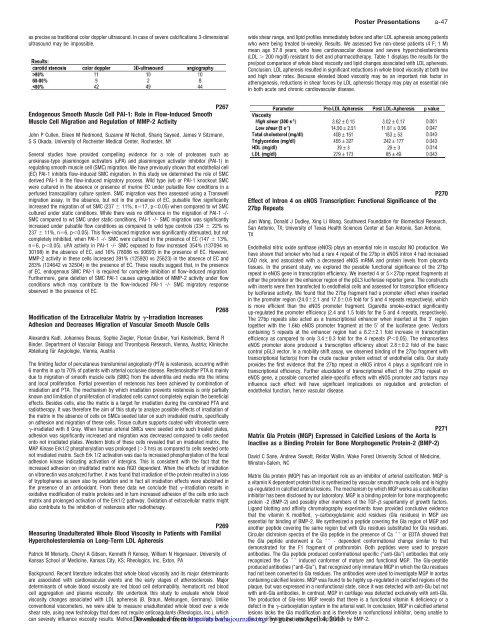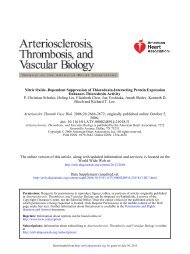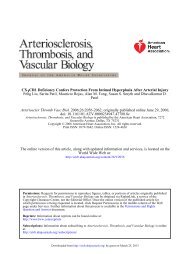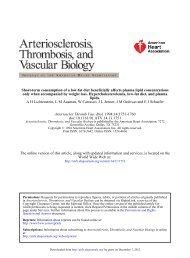Oral Presentations - Arteriosclerosis, Thrombosis, and Vascular ...
Oral Presentations - Arteriosclerosis, Thrombosis, and Vascular ...
Oral Presentations - Arteriosclerosis, Thrombosis, and Vascular ...
Create successful ePaper yourself
Turn your PDF publications into a flip-book with our unique Google optimized e-Paper software.
as precise as traditional color doppler ultrasound. In case of severe calcifications 3-dimensional<br />
ultrasound may be impossible.<br />
Endogenous Smooth Muscle Cell PAI-1: Role in Flow-Induced Smooth<br />
Muscle Cell Migration <strong>and</strong> Regulation of MMP-2 Activity<br />
John P Cullen, Eileen M Redmond, Suzanne M Nicholl, Shariq Sayeed, James V Sitzmann,<br />
S S Okada. University of Rochester Medical Center, Rochester, NY<br />
P267<br />
Several studies have provided compelling evidence for a role of proteases such as<br />
urokinase-type plasminogen activators (uPA) <strong>and</strong> plasminogen activator inhibitor (PAI-1) in<br />
regulating smooth muscle cell (SMC) migration. We have previously shown that endothelial cell<br />
(EC) PAI-1 inhibits flow-induced SMC migration. In this study we determined the role of SMC<br />
derived PAI-1 in the flow-induced migratory process. Wild type (wt) or PAI-1 knockout SMC<br />
were cultured in the absence or presence of murine EC under pulsatile flow conditions in a<br />
perfused transcapillary culture system. SMC migration was then assessed using a Transwell<br />
migration assay. In the absence, but not in the presence of EC, pulsatile flow significantly<br />
increased the migration of wt SMC (237 11%, n17, p0.05) when compared to wt SMC<br />
cultured under static conditions. While there was no difference in the migration of PAI-1 -/-<br />
SMC compared to wt SMC under static conditions, PAI-1 -/- SMC migration was significantly<br />
increased under pulsatile flow conditions as compared to wild type controls (334 22% vs<br />
237 11%, n6, p0.05). This flow-induced migration was significantly attenuated, but not<br />
completely inhibited, when PAI-1 -/- SMC were cultured in the presence of EC (147 13%,<br />
n6, p0.05). uPA activity in PAI-1 -/- SMC exposed to flow increased 354% (137094 vs<br />
30198) in the absence of EC, <strong>and</strong> 16% (78086 vs 90693) in the presence of EC. However,<br />
MMP-2 activity in these cells increased 391% (125920 vs 25623) in the absence of EC <strong>and</strong><br />
283% (124642 vs 32504) in the presence of EC. These results suggest that, in the presence<br />
of EC, endogenous SMC PAI-1 is required for complete inhibition of flow-induced migration.<br />
Furthermore, gene deletion of SMC PAI-1 causes upregulation of MMP-2 activity under flow<br />
conditions which may contribute to the flow-induced PAI-1 -/- SMC migratory response<br />
observed in the presence of EC.<br />
Modification of the Extracellular Matrix by -Irradiation Increases<br />
Adhesion <strong>and</strong> Decreases Migration of <strong>Vascular</strong> Smooth Muscle Cells<br />
P268<br />
Alex<strong>and</strong>ra Kadl, Johannes Breuss, Sophie Ziegler, Florian Gruber, Yuri Koshelnick, Bernd R<br />
Binder. Department of <strong>Vascular</strong> Biology <strong>and</strong> <strong>Thrombosis</strong> Research, Vienna, Austria; Klinische<br />
Abteilung für Angiologie, Vienna, Austria<br />
The limiting factor of percutaneus transluminal angioplasty (PTA) is restenosis, occurring within<br />
6 months in up to 70% of patients with arterial occlusive disease. Restenosisafter PTA is mainly<br />
due to migration of smooth muscle cells (SMC) from the adventitia <strong>and</strong> media into the intima<br />
<strong>and</strong> local proliferation. Partial prevention of restenosis has been achieved by combination of<br />
irradiation <strong>and</strong> PTA. The mechanism by which irradiation prevents restenosis is only partially<br />
known <strong>and</strong> limitation of proliferation of irradiated cells cannot completely explain the beneficial<br />
effects. Besides cells, also the matrix is a target for irradiation during the combined PTA <strong>and</strong><br />
radiotherapy. It was therefore the aim of this study to analyze possible effects of irradiation of<br />
the matrix in the absence of cells on SMCs seeded later on such irradiated matrix, specifically<br />
on adhesion <strong>and</strong> migration of these cells. Tissue culture supports coated with vitronectin were<br />
-irradiated with 8 Gray. When human arterial SMCs were seeded onto such treated plates,<br />
adhesion was significantly increased <strong>and</strong> migration was decreased compared to cells seeded<br />
onto not irradiated plates. Western blots of these cells revealed that on irradiated matrix, the<br />
MAP Kinase Erk1/2 phosphorylation was prolonged (3 hrs) as compared to cells seeded onto<br />
not irradiated matrix. Such Erk 1/2 activation was due to increased phosphorylation of the focal<br />
adhesion kinase indicating activation of intergins. This is consistent with the fact that the<br />
increased adhesion on irraditated matrix was RGD dependent. When the effects of irradiation<br />
on vitronectin was analyzed further, it was found that irradiation of the protein resulted in a loss<br />
of tryptophanes as seen also by oxidation <strong>and</strong> in fact all irradiation effects were abolished in<br />
the presence of an antioxidant. From these data we conclude that -irradiation results in<br />
oxidative modification of matrix proteins <strong>and</strong> in turn increased adhesion of the cells onto such<br />
matrix <strong>and</strong> prolonged activation of the Erk1/2 pathway. Oxidation of extracellular matrix might<br />
also contribute to the inhibition of restenosis after radiotherapy.<br />
P269<br />
Measuring Unadulterated Whole Blood Viscosity in Patients with Familial<br />
Hypercholesterolemia on Long-Term LDL Apheresis<br />
Patrick M Moriarty, Cheryl A Gibson, Kenneth R Kensey, William N Hogenauer. University of<br />
Kansas School of Medicine, Kansas City, KS; Rheologics, Inc, Exton, PA<br />
Background. Recent literature indicates that whole blood viscosity <strong>and</strong> its major determinants<br />
are associated with cardiovascular events <strong>and</strong> the early stages of atherosclerosis. Major<br />
determinants of whole blood viscosity are red blood cell deformability, hematocrit, red blood<br />
cell aggregation <strong>and</strong> plasma viscosity. We undertook this study to evaluate whole blood<br />
viscosity changes associated with LDL apheresis (B. Braun, Melsungen, Germany). Unlike<br />
conventional viscometers, we were able to measure unadulterated whole blood over a wide<br />
shear rate, using new technology that does not require anticoagulants (Rheologics, Inc.), which<br />
can severely influence viscosity results. Method. Downloaded We evaluated whole from<br />
blood viscosity over a<br />
http://atvb.ahajournals.org/<br />
Poster <strong>Presentations</strong> a-47<br />
wide shear range, <strong>and</strong> lipid profiles immediately before <strong>and</strong> after LDL apheresis among patients<br />
who were being treated bi-weekly. Results. We assessed five non-obese patients (4 F; 1 M)<br />
mean age 57.8 years, who have cardiovascular disease <strong>and</strong> severe hypercholesterolemia<br />
(LDL 200 mg/dl) resistant to diet <strong>and</strong> pharmacotherapy. Table 1 displays the results for the<br />
pre/post comparison of whole blood viscosity <strong>and</strong> lipid changes associated with LDL apheresis.<br />
Conclusion. LDL apheresis resulted in significant reductions in whole blood viscosity at both low<br />
<strong>and</strong> high shear rates. Because elevated blood viscosity may be an important risk factor in<br />
atherogenesis, reductions in shear forces by LDL apheresis therapy may play an essential role<br />
in both acute <strong>and</strong> chronic cardiovascular disease.<br />
P270<br />
Effect of Intron 4 on eNOS Transcription: Functional Significance of the<br />
27bp Repeats<br />
Jian Wang, Donald J Dudley, Xing Li Wang. Southwest Foundation for Biomedical Research,<br />
San Antonio, TX; University of Texas Health Sciences Center at San Antonio, San Antonio,<br />
TX<br />
Endothelial nitric oxide synthase (eNOS) plays an essential role in vascular NO production. We<br />
have shown that smoker who had a rare 4 repeat of the 27bp in eNOS intron 4 had increased<br />
CAD risk, <strong>and</strong> associated with a decreased eNOS mRNA <strong>and</strong> protein levels from placenta<br />
tissues. In the present study, we explored the possible functional significance of the 27bp<br />
repeat in eNOS gene in transcription efficiency. We inserted 4 or 527bp repeat fragments at<br />
either the promoter or the enhancer region of the pGL3 luciferase reporter gene. The constructs<br />
with inserts were then transfected to endothelial cells <strong>and</strong> assessed for transcription efficiency<br />
by luciferase activity. We found that the 27bp fragment had a promoter effect when inserted<br />
in the promoter region (24.02.1 <strong>and</strong> 17.00.6 fold for 5 <strong>and</strong> 4 repeats respectively), which<br />
is more efficient than the eNOS promoter fragment. Cigarette smoke-extract significantly<br />
up-regulated the promoter efficiency (2.4 <strong>and</strong> 1.5 folds for the 5 <strong>and</strong> 4 repeats, respectively).<br />
The 27bp repeats also acted as a transcriptional enhancer when inserted at the 3’ region<br />
together with the 1.6kb eNOS promoter fragment at the 5’ of the luciferase gene. Vectors<br />
containing 5 repeats at the enhancer region had a 8.22.1 fold increase in transcription<br />
efficiency as compared to only 3.40.3 fold for the 4 repeats (P0.05). The enhancerless<br />
eNOS promoter alone produced a transcription efficiency about 2.80.2 fold of the basic<br />
control pGL3 vector. In a mobility shift assay, we observed binding of the 27bp fragment with<br />
transcriptional factor(s) from the crude nuclear protein extract of endothelial cells. Our study<br />
provides the first evidence that the 27bp repeat in eNOS intron 4 plays a significant role in<br />
transcriptional efficiency. Further elucidation of transcriptional effect of the 27bp repeat on<br />
eNOS gene, a possible concerted allele-specific effects with eNOS promoter <strong>and</strong> factors may<br />
influence such effect will have significant implications on regulation <strong>and</strong> protection of<br />
endothelial function, hence vascular disease.<br />
P271<br />
Matrix Gla Protein (MGP) Expressed in Calcified Lesions of the Aorta Is<br />
Inactive as a Binding Protein for Bone Morphogenetic Protein-2 (BMP-2)<br />
David C Sane, Andrew Sweatt, Reidar Wallin. Wake Forest University School of Medicine,<br />
Winston-Salem, NC<br />
Matrix Gla protein (MGP) has an important role as an inhibitor of arterial calcification. MGP is<br />
a vitamin K dependent protein that is synthesized by vascular smooth muscle cells <strong>and</strong> is highly<br />
up-regulated in calcified arterial lesions. The mechanism by which MGP works as a calcification<br />
inhibitor has been disclosed by our laboratory. MGP is a binding protein for bone morphogenetic<br />
protein -2 (BMP-2) <strong>and</strong> possibly other members of the TGF- superfamily of growth factors.<br />
Lig<strong>and</strong> blotting <strong>and</strong> affinity chromatography experiments have provided conclusive evidence<br />
that the vitamin K modified, -carboxyglutamic acid residues (Gla residues) in MGP are<br />
essential for binding of BMP-2. We synthesized a peptide covering the Gla region of MGP <strong>and</strong><br />
another peptide covering the same region but with Glu residues substituted for Gla residues.<br />
Circular dichroism spectra of the Gla peptide in the presence of Ca or EDTA showed that<br />
the Gla peptide underwent a Ca - dependent conformational change similar to that<br />
demonstrated for the F1 fragment of prothrombin. Both peptides were used to prepare<br />
antibodies. The Gla peptide produced conformational specific (“anti-Gla”) antibodies that only<br />
recognized the Ca induced conformer of mature <strong>and</strong> functional MGP. The Glu-peptide<br />
produced antibodies (“anti-Glu”), that recognized only immature MGP in which the Glu residues<br />
had not been converted to Gla residues. The antibodies were used to investigate MGP in aortas<br />
containing calcified lesions. MGP was found to be highly up-regulated in calcified regions of the<br />
plaque, but was expressed in a nonfunctional state, since it was detected with anti-Glu but not<br />
with anti-Gla antibodies. In contrast, MGP in cartilage was detected exclusively with anti-Gla.<br />
The production of Gla-less MGP reveals that there is a functional vitamin K deficiency or a<br />
defect in the -carboxylation system in the arterial wall. In conclusion, MGP in calcified arterial<br />
lesions lacks the Gla modification <strong>and</strong> is therefore a nonfunctional inhibitor, being unable to<br />
bind to orby inhibit guest the initiation on April of calcification 4, 2013 by BMP-2.














